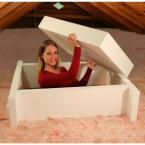And what does “Attic Bypass” mean?
As a home inspector in the Stillwater, MN area, I consider the attic to be a major source of information about the house. I look for levels of insulation and ventilation, of course. It’s easy to understand that insulation is like a blanket that keeps heat in. The importance of proper ventilation is a little less clear, but only a little.
What is VERY important and LESS understood is the presence of moisture in the attic. I look for frost on the nails from the shingles. (Yes. there SHOULD be nails poking through the roof decking; the shingles stay on longer when the nails poke through about a quarter of an inch). Frost on the nails mean that moisture has found the coldest spots to condense. (Frost itself is not a problem, but when it melts. the water causes damage. But I’m getting ahead of myself.) In the summertime, I look for rust on those nails, and/or “tiger stripes”, or dark stains on the wood where the nails are.
It’s usually pretty easy to locate and repair the major causes of moisture in the attic, the biggest one being improperly installed bathroom vents. We could talk about air scrubbing and such, but there are only a few things to remember about bathroom vents; they should be:
- Straight and smooth as possible;
- Sealed at the roof to a vent with a damper (that opens and closes – sometimes the dampers stick);
- Insulated;
- Sealed at the attic floor.
Another major source of moisture penetration and heat loss is the attic access itself.
The attic access panel is relatively easy to seal with caulk. There really aren’t many times that someone needs to get into the attic, although you could install weatherstripping if you didn’t want to re-apply the caulk every time you opened the hatch. Speaking of attic hatches, consider replacing it with an attic access hatch kit, found in home centers for about $60. You can learn more about it by clicking: New Attic Hatches.
The best way to prevent warm, moist air from getting into the attic is by sealing all the bypasses, even the relatively small ones. There isn’t a lot of space around the wires that go to the ceiling lights, but there are a lot of bypasses like that, and it adds up to a lot of air getting through. This may or may not be a DIY project, but there are a lot of companies that can do the job. Most insulating companies seal attic bypasses as a regular part of an insulation job.
Still, doing it yourself might make sense. To learn more about what the job entails, click: DIY Sealing Attic Bypasses.



